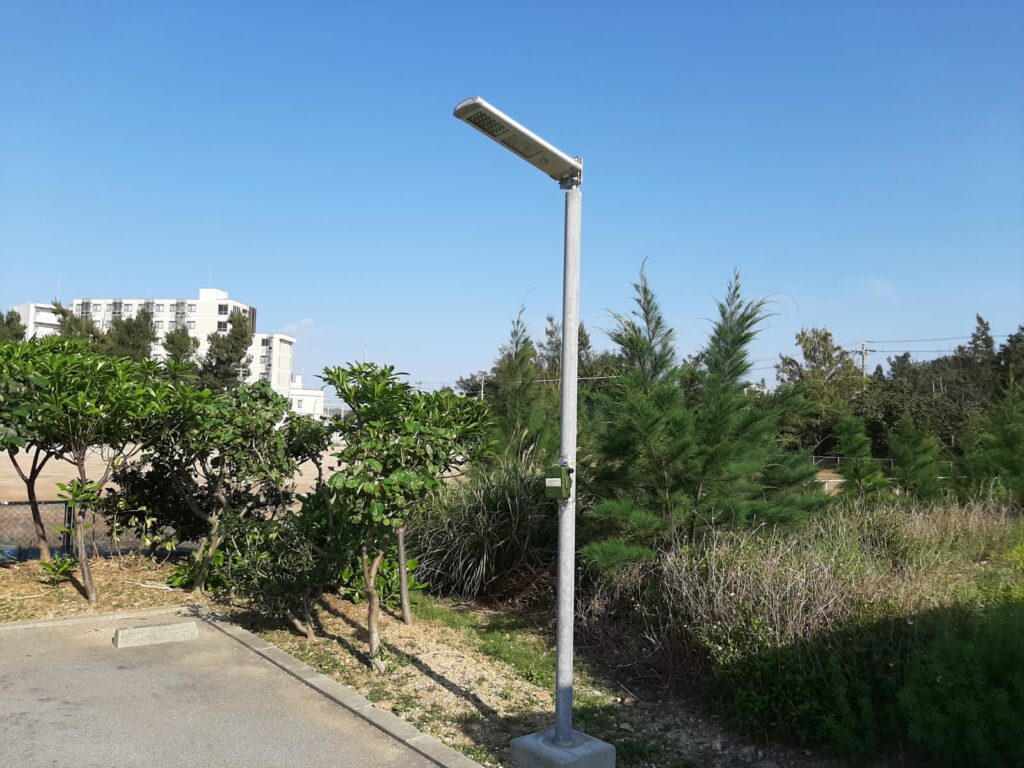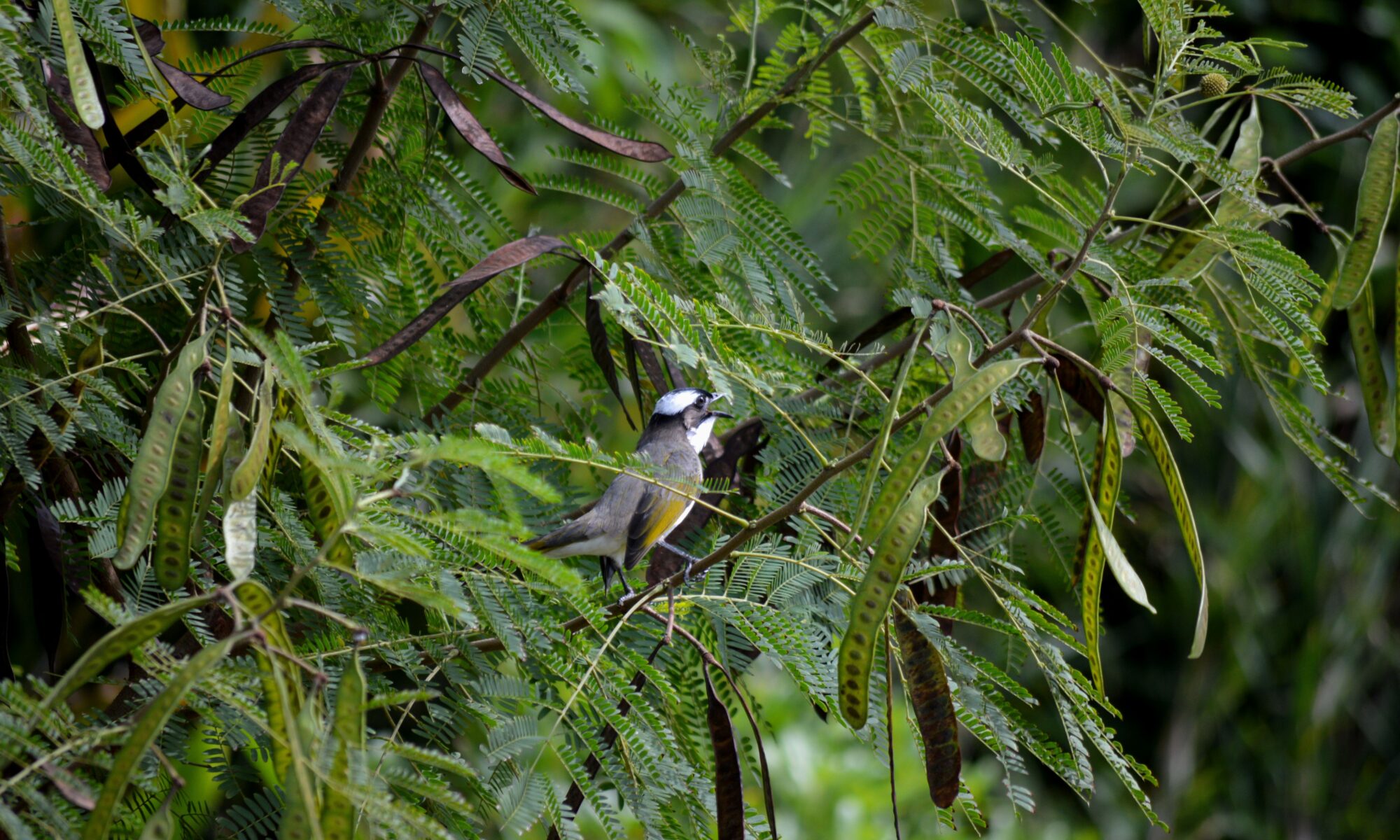- Separating signal from noise in acoustic biodiversity surveys - 17/11/2020
- Sustainable redevelopment: visions of a post-lockdown world - 29/05/2020
- Pedagogy in Portugal - 07/02/2020
Another sunrise brings another day of working from my hotel room. But today there’s a difference; the rain has eased and a smattering of sunshine dances on my balcony. I open my door and am struck by the fresh ocean breeze. It’s that fleeting time of year when Okinawa’s oppressive humidity is kept at bay by rain showers, producing occasional perfect days. I can practically taste the salt of the ocean as I watch the gentle lull of a distant fishing boat. But perhaps most noticeably, my ears prick up at the melodic and almost metallic cha-ko-lee of a pair of light-vented bulbuls (Pycnonotus sinensis) passing by. I watch the birds for a second before my eyes trail slowly back to the sea. Just as they do, I catch a flash of red. It must have been a ruddy kingfisher (Halcyon coromanda) darting from the tree it was perched in. A few minutes later my identification is confirmed as I hear the sweeping, descending call of the individual in question.
I’m lucky to be in Okinawa with such wonderful fauna and flora, but my sentiment is a shared one. People around the world are taking note of their local wildlife more than ever before because of the travel restrictions, writes Prof. Yvonne Buckley in the Irish Times. Right now, people have no choice but to stay local, and in heavily urbanised spaces, it can be harder to find greenspace and absorb its corresponding mental and physical health benefits.
Experts are urging people to soak in nature in urban areas and even from inside our homes by making use of ‘virtual nature’ in the form of webcams and nature documentaries. And it seems like people are listening (both to the expert advice and to the birdsong around them). People are looking to the horizon, and where there’s nothing but urban sprawl, they’re looking down. Some are even helping to draw attention to our urban flora by naming the plants we walk past every day.
But it’s not just the stay home and stay local restrictions that are causing people to take note. Where cities are on lockdown, traffic data from around the world gives us a fascinating insight into how travel restrictions are playing out on our streets (see these very enjoyable interactive time series by The Guardian and explore the traffic levels of hundreds of cities). There’s already evidence that traffic restrictions are reducing air pollution in some urban areas. An equally positive result of traffic restrictions is the change to the sounds of our cities. Without the perpetual hum of the nearest road or the pulsating ebb and flow of the daily commute, nature’s chorus reverberates around our neighbourhoods, uninterrupted perhaps for the longest period in decades.
In fact, researchers from around the world have banded together (from afar, of course!) to try to monitor the changes our cities are undergoing during the COVID-19 lockdown. I’m just one small cog in the Silent Cities project, a huge global effort to record urban soundscapes during quarantine and as restrictions are gradually lifted. The project is open to anyone with suitable recording equipment (an Open Acoustics AudioMoth, SongMeter SM4, or similar) and from anywhere in the world. There are already records from around Europe, the Americas, and a few in Africa, Asia and Oceania (see map), and soon we’ll be putting Okinawa on that map. I’m really excited to see how the project develops over the coming months.


As our use of urban spaces has changed over the past few weeks and months, local nature has certainly become more noticeable for many of us. But it’s not just our restricted outside time that’s increasing our awareness of nature locally. Some animals are exploiting our cities in our absence. While we’re spending less time outside, animals have changed their movement and behaviour. Wild boar are roaming the streets of Haifa, Israel, while residents remain indoors. Two rival ‘gangs’ of monkeys are fighting over scraps of food in the Thai city of Lopburi, in the primate equivalent of Romeo and Juliette (putting aside for a moment that of course, Leonardo DiCaprio is himself a primate…). We’re seeing changes to farming practices during lockdown with insect-harming pesticide use at a record low, meaning wild bees are foraging in a friendlier world than they’ve witnessed in years.

Of course, the internet has gone wild in response (I will not be apologising for that pun). I’ve thoroughly enjoyed all the jokes and memes citing ‘nature is healing, we are the virus’ which poke fun at all the nature optimism on social media. Some of the best have included buffalo returning to Buffalo in New York, Furbies (any 90s kids out there?) returning to the wild, and perhaps my favourite is a tweet with the caption “wildlife is finally returning to the streets of Paris. Nature is healing” overlaid on photos of baguettes strewn across a Parisian pavement. These enjoyable hoaxes are prompted by the genuine observations that changes to human movements and land use directly influence the behaviour, movements, and phenology (timing of lifecycle events) of wildlife.

The world has undoubtedly changed, with some changes (such as wildlife thriving) seemingly for the better. This begs the question of how we can capitalise on these positive changes in a post-lockdown world. Can we avoid regressing into a mindset of overexploitation that puts economic growth before all else? I would argue that the sustainable development we’ve been dragging our heels over for decades has failed us. It has largely been business as usual for most of us. So perhaps it’s time to shift focus away from sustainable development, towards sustainable redevelopment.
As the global economy recovers in the coming months and years, we must reassess even our most firmly entrenched values. Ask ourselves what’s needed to meet our global sustainability goals? I’d largely echo BBC Environment Analyst Roger Harrabin’s call to action in this excellent article, with the exception of one key thing: we have, right now, the capacity to beat climate change. We have the tools and technology, the data and understanding, the ideas and innovators needed for a green revolution.
The main things halting progress are willpower and legislation. Social movements like Extinction Rebellion are demonstrable evidence that climate change and the global biodiversity crisis are evocative issues, and the core of global conversations. Next we need laws and leadership to make these issues the priority they ought to be. The fantastic documentary ‘2040’ shows a green vision of the year—you guessed it—2040 based on currently available technology. The film provides a thought-provoking and uplifting discourse on the way we travel and use our urban spaces, the way we get our energy, fuel our homes, and fuel our economies. It’s well worth a watch, filling the almost vacant niche of positive and motivating documentaries about global environmental and economic practices.
Our streets are cleaner. Our cities, quieter. Wildflowers bloom by the roadside. This isn’t a utopian view of the future; this is happening outside our doors right now. If we return to business as usual, forcing nature out of our cities, we drive away its aesthetic value, mental health benefits, and climate change mitigation potential. I really hope we can seize this crisis as an opportunity to build a greener society; one that values how people and nature interact, rather than assigning them to separate boxes. During this pandemic, there has been much talk about ‘flattening the curve’ to prevent vital healthcare systems being overwhelmed. Analogously, climate change has a curve much steeper than any we’ve faced before. We must invest deftly and selectively to flatten the climate curve and prevent nature—our planet’s healthcare system—from being overwhelmed. So, I confess that perhaps sustainable development was a big ask. But with the right attitude, sustainable redevelopment doesn’t have to be.

